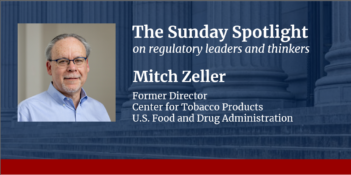
A fight over fishery regulations could spell trouble for Chevron deference.
Has the Supreme Court announced the beginning of the end of an important but controversial legal doctrine known as Chevron deference?
Last month, the Supreme Court decided it would hear a case contesting a National Marine Fisheries Service (NMFS) rule requiring certain regulated fishing vessels not only to carry federal monitoring personnel onboard, but also to pay the salaries of these monitors if federally funded inspectors are unavailable. Vessel operators went to court to protest NMFS’s imposition of financial obligations on it under the rule.
After losing in the lower courts, the fishing operators have appealed to the Supreme Court. In accepting the appeal, the Court announced that it will be focusing its review on one question: whether to overrule—or at least clarify—a Supreme Court precedent known as Chevron v. NRDC.
Decided in 1984 by a unanimous court, Chevron established a two-pronged approach for lower federal courts to follow when interpreting federal agencies’ interpretations of ambiguous statutory provisions. First, if a provision’s statutory language is “unambiguous,” a court must reject any agency’s position that is “contrary to clear congressional intent.” But if the statute is deemed “silent or ambiguous,” then a court must analyze whether the agency’s construction is reasonable, and therefore permissible.
If a statute is ambiguous but leaves a gap in the statutory scheme, the Court takes its direction from whether agency discretion is explicit or implicit. If the statute is ambiguous but explicitly gives agencies authority to fill a gap, Chevron concluded that the agency interpretation should be given “controlling weight” as long as the interpretation is not “arbitrary, capricious, or manifestly contrary” to the statute. If a court deems Congress to have delegated authority to an agency only implicitly, a court still “may not substitute its own construction” as long as the agency’s interpretation is reasonable.
Overall, the Supreme Court in Chevron viewed gaps—either express or implied—left by Congress in statutory schemes as intentional delegations of authority to the agency deserving of deference.
The principle of judicial deference lies at the heart of Chevron, as does courts’ respect for agencies’ reasonable interpretations of both their enabling acts and other statutory grants of power. Furthermore, Chevron deference to agencies has been explored and dissected more than almost any other Supreme Court decision ever issued.
In the recent case involving NOAA’s fisheries rule—Loper Bright Enterprises v. Raimondo—the appellants are four family-owned and -operated Atlantic herring fishing companies. The companies argue that the Magnuson-Stevens Act (MSA) does not authorize the NMFS, which resides within the U.S. Department of Commerce’s National Oceanic and Atmospheric Administration (NOAA), to mandate industry-funded monitoring. The appellants underscore that monitors not only occupy precious real estate onboard tight vessels, but also that maintaining this enforcement regime costs fishing companies dearly, as the bill can total 20 percent of their gross returns.
Earlier in the case’s history, a federal district court concluded that, under the Chevron two-step analysis, the statutory text in the MSA explicitly provided NMFS the authority to require at-sea monitors. The court also held that NMFS was acting within its statutory authority to require any “necessary and appropriate” measures for conservation and management, which implicitly included requiring the fishing industry itself to fund the monitoring.
The trial court also ruled that another provision in the MSA authorizing sanctions on vessels that fail to pay for observer services “provided to or contracted by an owner or operator” further supported the reasonableness of NMFS’ interpretation—even if a portion of the statute could be considered ambiguous.
A divided panel of the U.S. Court of Appeals for the D.C. Circuit affirmed the trial court’s determinations by again applying the Chevron two-step analysis, but finding the MSA ambiguous. The appeals court acknowledged that the current Supreme Court, although not in the habit of using Chevron analysis for some time, is the only court able to overrule Chevron.
Judge Walker dissented from the appellate court’s decision. He argued that NMFS interpretation was an improper attempt to work around the dual constraints of congressionally appropriated funds and a federal prohibition on agencies collecting fees and keeping the money for their own purposes, absent express statutory authority. He noted that “agencies are creatures of Congress, so they have no authority apart from what Congress bestows.”
Judge Walker also emphasized that congressional silence on a given issue does not create automatic ambiguity. On the contrary, if all else is equal, it indicates a lack of authority, he noted. He repudiated NMFS’ trinity of provisions from the MSA, contending that no other agency context allows inspection regimes to be funded without express direction from Congress. Judge Walker pointed to the explicit industry-funded monitoring of certain fisheries enumerated in the MSA as rebutting the implicit assertion of “silently” allowing all fisheries to fund observers in any way they please.
In asking the Supreme Court to take up their case, the fishing companies contend that the D.C. Circuit’s decision eviscerated a practical limit on Congress’ sole power of the purse on federal agencies. They also argue more broadly that Chevron has led to lower courts’ disastrous abdication of “the core judicial responsibility of statutory construction.” They further claim that, as a result, the Code of Federal Regulations has seen “exponential growth” and that “unaccountable agencies” have proceeded to overregulate. Because of these practical effects, they conclude that Chevron must be overruled or clarified.
At a minimum, the fishing companies insist that their appeal gifts the Supreme Court “an opportunity to clarify that silence is not ambiguity, especially when it comes to an extraordinary power that is expressly conveyed elsewhere in the statute.” They observe that virtually every agency has some residual “necessary and appropriate” clause, and that if the kind of fundraising embedded in the NMFS rule is allowed to proceed unfettered, executive aggrandizement will only increase.
The government contends, in response to the fisheries’ appeal, that asking the Court to overrule Chevron is a heavy burden, especially because decades of federal court decisions have invoked it, Congress has repeatedly legislated in its shadow, and regulated entities continue to rely on interpretations upheld under its analysis. The government argues that, without a “special justification” grounded in fact, overturning such a deeply engrained part of administrative law is not warranted.
Even if the Court does overturn or prune Chevron next term, the legacy and ideas of agency expertise and judicial deference embodied within that decision may continue to live on in one form or another. Supporters of administrative agencies and regulated industries alike will be watching—and perhaps holding their breath—until the Court hands down its decision in Loper Bright Enterprises.



